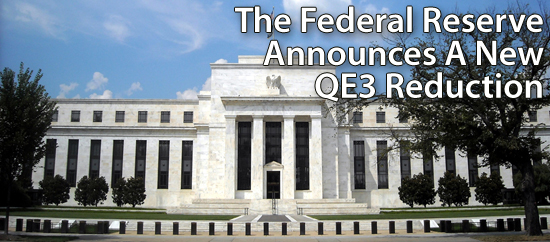Fed Cuts QE3 For Fifth Straight Meeting; 30-Year Mortgage Rates Drop Anyway

Mortgage rates are improving after the Federal Reserve's June 2014 FOMC meeting.
The central banker described the U.S. economic growth as having "rebounded" recently, after having "slowed sharply" during the winter months. The group acknowledged inflation rates as less-than-optimal, and announced the next phase of its QE3 taper, to begin in July.
QE3 is a economic stimulus program which aims to suppress U.S. mortgage rates. As the size of QE3 shrinks, mortgage rates are expected to rise. The July taper marks the fifth round of reductions to the QE3 program.
Click here to see today's mortgage rates.
Unanimous Vote, No Change In Rates
Wednesday, for the 45th consecutive meeting, the Federal Open Market Committee (FOMC) voted to leave the Fed Funds Rate unchanged near 0.000 percent, extending the Federal Reserve's highly accommodative fiscal policy by another six weeks, at least.
In addition, the group elected to reduce the size of its current quantitative easing program, a program more commonly known as "QE3".
The moves did not surprise Wall Street. The Fed Funds Rate is expected to to remain near zero percent deep into 2016; and the Federal Reserve has been vocal that QE3's wind-down would be measured and steady, barring economic shock.
The Fed continues to leave a watchful eye on inflation, though.
Today's rate of inflation barely exceeds one percent -- the range in which it's been for more than one year. To the Fed, a one-percent inflation rate is too low.
The Fed believes that inflation should run near 2% to promote a healthy U.S. economy, and it makes this point four separate times in its press statement.
Previously, the Fed has said it will hold the Fed Funds Rate near zero percent for as long as the unemployment rate is above 6.5%. Now, the Fed is using inflation rates as its key market metric.
Note that the group's ZIRP (Zero-Interest Rate Policy) helps to lift inflation rates.
The Federal Reserve used June's post-meeting press release to note that household spending "appears to be rising moderately" ; and to say that the housing market's recovery remains slow.
The Fed also continues to monitor employment and labor markets, as dictated by its charter. Unemployment rates "remains elevated"; and labor market indicators "showed further improvement".
Compare today's new mortgage rates here.
Mortgage Interest Rate Stimulus Plan To Shrink
The Federal Reserve also announced that it will reduce the size of of its third quantitative easing round, a program known as QE3.
The Fed first announced QE3 in September 2012. Via the program, the Federal Reserve said it would $85 billion in long-term bonds monthly, split between U.S. Treasury bonds and mortgage-backed securities (MBS).
As a net purchaser of bonds, the Federal Reserve aimed to raise demand for long-term bonds which, in turn, would cause their prices to fall. For U.S. consumers, this would mean lower mortgage rates available via banks and mortgage brokers.
QE3 was a success. With weeks of its launch, U.S. mortgage rates had dropped to their lowest point ever and refinancing surged -- especially for the government's HARP 2 mortgage refinance.
Now, the Fed is phasing QE3 out.
After its December 2013 meeting, the Federal Reserve announced a ten billion dollar cut the program, split evenly between Treasuries and mortgage bonds. After its January 2014 meeting, it elected to do the same, in the same proportions.
The April meeting marks the fourth reduction to QE3 -- again a $10 billion cut.
QE3 purchases are now comprised of $20 billion in U.S. Treasuries and $15 billion in mortgage-backed bonds monthly, to begin in July. The taper loosens further the artificial cap that the Fed has placed on mortgage rates.
As QE3 shrinks, mortgage rates are expected to rise.
What Will Mortgage Rates Do Now?
Mortgage rates are improving after the Federal Reserve's June meeting, adding to this year's gains. 30-year mortgage rates are near their lowest point of the year. Purchase and refinance opportunities are plentiful nationwide.
Compare today's low rates here. Rates are available at no cost, with no obligation, and with no social security number required to get started.
Click to compare mortgage rates now.
The information contained on The Mortgage Reports website is for informational purposes only and is not an advertisement for products offered by Full Beaker. The views and opinions expressed herein are those of the author and do not reflect the policy or position of Full Beaker, its officers, parent, or affiliates.
Copyright Full Beaker, Inc. 2014; Some Images Copyright (c) 123RF Stock Photos
http://themortgagereports.com/14647/fomc-statement-qe3-mortgage-rates